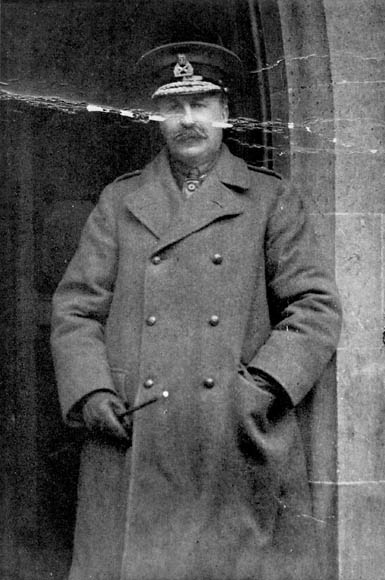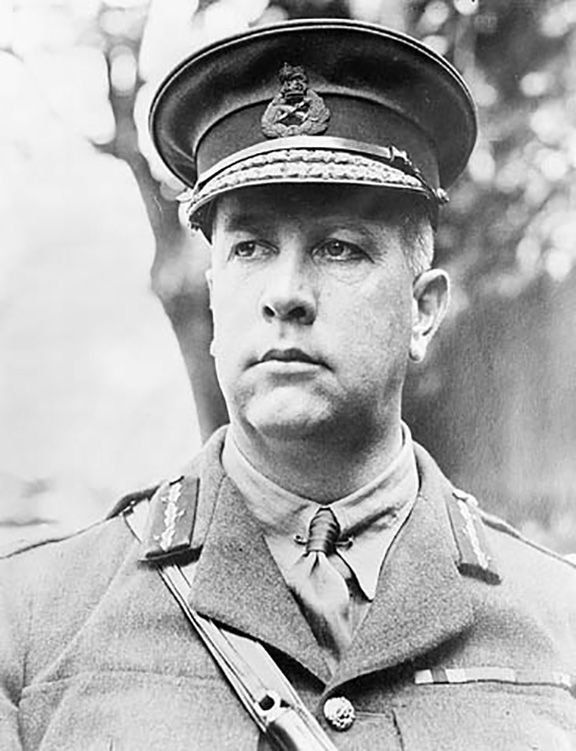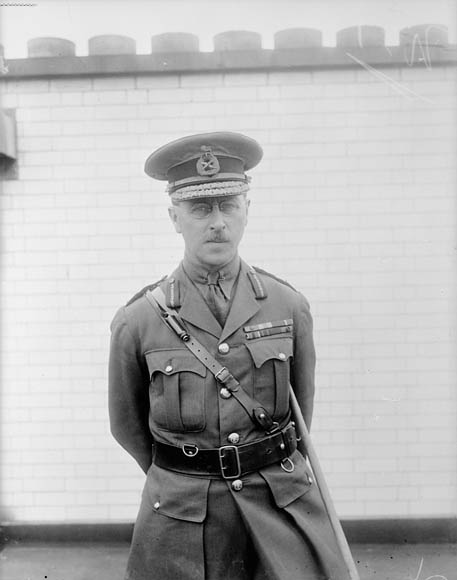St. Julien
First World War
Date
24 April – 4 May 1915

Lieutenant-General Edwin Alfred Hervey Alderson (1859-1927), commander First Canadian Division (1914-15), commander Canadian Army Corps (1915-16), inspector-general, Canadian forces (1916-18). Location unknown. 1915.
Credit: Library and Archives Canada/C-49485; (MIKAN no. 3212819)
Geographical parameters
The Comines – Ypres Canal as far as Voormezeele: then road to Vlamertinghe Château – Elverdinghe Château – Boesinghe – Langemarck
Context
A battle honour formally entitled the “Battle of St. Julien” and itself being part of “The Battles of Ypres, 1915”Footnote 1.
Description
This Honour “St. Julien” was awarded to Canadian units for their actions defending against the German attack of 24 April 1915. The Battle of St. Julien began with the second gas attack by the Germans at Ypres directed at the “Apex” in the line formed as a result of the attack on 22 April. The front line of Apex was held by the 2nd (Brigadier-General A.W. Currie) and 3rd (Brigadier-General R.E.W. Turner, VC) Canadian Brigades. At four in the morning on 24 April 1915 a German artillery bombardment began and simultaneously they released chlorine gas in the direction of the lines held by 1st Canadian Division (Lieutenant-General E.A.H. Alderson). The gas was centred on the junction of 2nd and 3rd Brigades, falling most heavily on the 8th and 15th Battalions. Even under the strenuous conditions caused by the gas, the Canadian front line battalions were able to momentarily halt the initial waves of Germans. Heroic fighting by those units allowed the Canadian brigades to withdraw to positions along the Gravenstafel Ridge.
The Germans launched a simultaneous attack between Kitcheners Wood and Keerselare. Despite their best efforts, the Canadian front-line units only gave some pause to the German attack. Almost overrun, they withdrew to positions along the Gravenstafel Ridge while several British battalions arrived in the Canadian sector to help reinforce the lines. Despite severe confusion and conflicting messages to and from commanders, new defensive positions were gradually established. Only the 2nd Brigade, on the far right of the Canadian line, still held part of its original front line at the end of the day on the 24th of April.
In the early morning of the 25th, a British brigade launched a counter-attack in the area between Kitcheners Wood and St-Julien. Even if objectives were not reached, it blocked a gap in the line and caused the Germans to commit troops that were supposed to conduct an attack of their own in this area. This German attack at Kitcheners Wood was supposed to be coordinated with an attack on the 2nd Canadian Brigade in the Apex in the line North of Gravenstafel. Canadian units held the line for most of the day but by evening, the German attack forced the Canadians back behind Gravenstafel. The remaining troops of the Brigade were relieved in place by a British unit. The remainder of the Canadian Division was gradually relieved in place by British units with most Canadians out of the line on the 26th of April.
That brought an end to the fighting for the infantry battalions of the 1st Canadian Division in the Battle of St-Julien, although British units continue to fight in the area for several more days. The Headquarters of the 1st Canadian Division remained in command of its area on 2 May and Canadian Artillery batteries continued to support British formations until 19 June 1915.

General Currie, Commander of the Canadian troops in France, and A.D.C. Location unknown. June, 1917.
Credit: Canada. Department of National Defence/Library and Archives Canada/PA-001370 (MIKAN no. 3191901)

Lieutenant General R.E.W. Turner, V.C. Location unknown. 1914-1919.
Credit: Canada. Department of National Defence/Library and Archives Canada/PA-007941 (MIKAN no. 3221894)
Awarded to:
Currently Serving Units
- 48th Highlanders of Canada
Awards to the 15th Canadian Infantry Battalion, CEF (GO 110/29) and The 48th Regiment (Highlanders) (GO 110/29) - 56th Field Artillery Regiment, RCA
Awards to the 4th Canadian Infantry Battalion, CEF (GO 110/29) and The Dufferin Rifles of Canada (GO 110/29 - The Black Watch (Royal Highland Regiment) of Canad.
Awards to the 13th Canadian Infantry Battalion, CEF (GO 110/29) and The Royal Highlanders of Canada (GO 110/29) - The British Columbia Regiment (Duke of Connaught's Own)
Awards to the 7th Canadian Infantry Battalion, CEF (GO 71/30) and the 1st British Columbia Regiment (Duke of Connaught's Own) (GO 110/29) - The Calgary Highlander.
Awards to the 10th Canadian Infantry Battalion, CEF (GO 123/29) and The Calgary Highlanders (GO 110/29) - The Canadian Scottish Regiment (Princess Mary's.
Awards to the 16th Canadian Infantry Battalion, CEF (GO 110/29) and The Canadian Scottish Regiment (GO 110/29) - Governor General's Foot Guards
Awards to the 2nd Canadian Infantry Battalion, CEF (GO 123/29) and The Governor General's Foot Guards (GO 32/32) - The North Saskatchewan Regiment.
Awards to the 5th Canadian Infantry Battalion, CEF (GO 110/29) and The Saskatoon Light Infantry (GO 110/29) - The Queen's Own Rifles of Canada.
Awards to the 3rd Canadian Infantry Battalion, CEF (GO 123/29) and The Queen's Own Rifles of Canada (GO 110/29) - The Royal Canadian Regiment
Awards to the 1st Canadian Infantry Battalion, CEF (GO 110/29) and The Canadian Fusiliers (City of London Regiment) (GO 110/29) - The Royal Hamilton Light Infantry (Wentworth Regiment.
Awards to the 4th Canadian Infantry Battalion, CEF (GO 110/29) and The Royal Hamilton Light Infantry (GO 110/29) - The Royal Montreal Regiment.
Awards to the 14th Canadian Infantry Battalion, CEF (GO 110/29) and The Royal Montreal Regiment (GO 110/29) - The Royal Regiment of Canada.
Awards to the 3rd Canadian Infantry Battalion, CEF (GO 123/29) and The Toronto Regiment (GO 110/29) - The Royal Winnipeg Rifle.
Award to the 8th Canadian Infantry Battalion, CEF (GO 110/29), the 10th Canadian Infantry Battalion, CEF (GO 123/29), The Winnipeg Light Infantry (GO 110/29), and The Winnipeg Rifles (GO 110/29) - The South Alberta Light Horse
Award to the 19th Alberta Dragoons (GO 71/30)
Unit on the Supplementary Order of Battle
- 50th Field Artillery Regiment (The Prince of Wales' Rangers), RCA
Awards to the 2nd Canadian Infantry Battalion, CEF (GO 123/29) and The Peterborough Rangers (GO 110/29)
Page details
- Date modified: